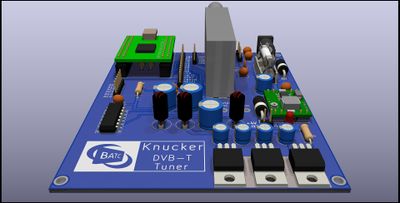Difference between revisions of "Knucker"
| Line 59: | Line 59: | ||
====USB Module==== | ====USB Module==== | ||
| − | The USB module will require reprogramming with the xml file in this zip using the FTDI program called FT prog - the standard MiniTiouner USB module from the BATC will not work but can be re-programmed. | + | The USB module will require reprogramming with the xml file in this zip using the FTDI program called FT prog - the standard MiniTiouner USB module from the BATC will not work but can be re-programmed. |
| + | After reprogramming confirm you have been succesful by doing a "scan and parse" action and ensuring that ProductDesc is shown as 'CombiTuner-Express' | ||
| + | |||
[[:File:combituner.zip]] | [[:File:combituner.zip]] | ||
Revision as of 14:18, 9 January 2021
The Knucker project is to develop a variable bandwidth DVB-T USB receiver and transmitter for use on the lower VHF bands and HF. It will also have applications for mobile stations on 437MHz and above.
Why DVB-T
DX!!
DVB-T can be used in environments where phase distortion and multi-pathing means DVB-S does not work. Typical applications include mobile video transmissions and bands below 70MHz :-)
We don't need DVB-T except for 29 / 50 MHz and mobile - it won't replace DVB-S for other bands and QO100!
Why Knucker
Why not?
Knucker is a dialect word for a kind of water dragon, living in knuckerholes in Sussex and Charles, the lead developer, also lives in Sussex....
https://en.wikipedia.org/wiki/Knucker
Timescales
December 2020 - Currently the project is at the design phase with a proof of concept receiver working on bread board hardware.
Receiver
Hardware
Charles G4GUO and the Knucker team have developed a variable bandwidth DVB-T receiver with USB interface around the Serit 4762 NIM / tuner.
Draft specifications are 100KHz to 2MHz wide OFDM, frequency range 44 to 1002MHz
Note: the 4762 NIM is capable of DVB-T and DVB-S but the DVB-S is NOT (repeat NOT) supported in any BATC applications due to restricted frequency range and lack of low SR capability.
The PCB design by Mike G0MJW is based on the MiniTiouner Version 2 board.
Version 1
Feasibility design which was never built.
Version 2
This was the first protype build and not on general release - BOM and schematics are available here: File:Knucker.xlsx
Version 3
First general release PCB - if you bought your PCB from the BATC shop, this is the information you need.
Note the use of a 3 pin 1.2v regulator which is different from the 5 pin variable 1.2v regulator on the MiniTuioner V2 PCB
Schematic is here: File:Knucker schematic V3.pdf
BOM is here File:knucker BOM V3.xlsx
USB Module
The USB module will require reprogramming with the xml file in this zip using the FTDI program called FT prog - the standard MiniTiouner USB module from the BATC will not work but can be re-programmed. After reprogramming confirm you have been succesful by doing a "scan and parse" action and ensuring that ProductDesc is shown as 'CombiTuner-Express'
Full instructions on how to program the unit are here: http://www.vivadatv.org/viewtopic.php?f=80&t=379
Software
It is intended to develop a core Linux DVB-T receiver application that will be integrated into the LongMynd receiver core.
The first product implementation will be in the Portsdown DATV system which will be enhanced to include a DVB-T receiver. Dave G8GKQ released the first alpha code for testing in early January 2021.
It is also envisaged that a set-top box version of the code will be developed at some point using the RydePlayer and would be known as the Knucker receiver.
Transmit
DATV Express
Charles G4GUO has developed a variable bandwidth OFDM version of the DATVexpress software. Version 1.25lp17 works for DVB-T with the DATV Express card.
It does work in some configurations with the Pluto (and possibly the LimeSDR) but these SDRs are not yet properly supported.
For initial testing, set the DATV Express to use Mono MPA audio and DVB-T using the settings shown below.



